
The carrion crow is a passerine bird of the family Corvidae, native to western Europe and the eastern Palearctic.
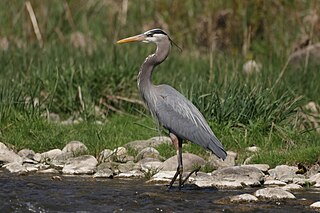
The great blue heron is a large wading bird in the heron family Ardeidae, common near the shores of open water and in wetlands over most of North and Central America, as well as far northwestern South America, the Caribbean and the Galápagos Islands. It is occasionally found in the Azores and is a rare vagrant to Europe. An all-white population found in south Florida and the Florida Keys is known as the great white heron. Debate exists about whether these white birds are a color morph of the great blue heron, a subspecies of it, or an entirely separate species.

The little raven is a species of the family Corvidae that is native to southeastern Australia. An adult individual is about 48–50 cm (19–19.5 in) in length, with completely black plumage, beak, and legs; as with all Australian species of Corvus, the black feathers have a grey base, and the iris of the adult bird is white . Although the little raven was first named by Gregory Mathews in 1912, it was only in 1967 that there was consensus to separate it from the Australian raven as a distinct species.
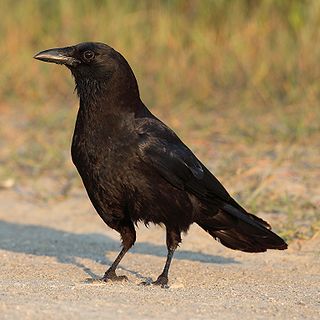
The American crow is a large passerine bird species of the family Corvidae. It is a common bird found throughout much of North America. American crows are the New World counterpart to the carrion crow and the hooded crow of Eurasia; they all occupy the same ecological niche. Although the American crow and the hooded crow are very similar in size, structure and behavior, their calls and visual appearance are different.

Steller's jay is a bird native to western North America and the mountains of Central America, closely related to the blue jay found in eastern North America. It is the only crested jay west of the Rocky Mountains. It is also sometimes colloquially called a "blue jay" in the Pacific Northwest, but is distinct from the blue jay of eastern North America. The species inhabits pine-oak and coniferous forests.
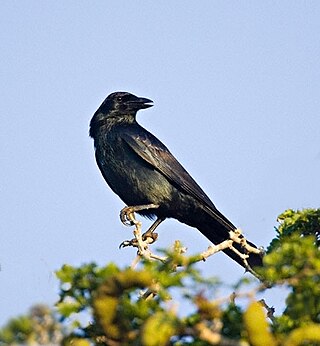
The Tamaulipas crow is a crow found in northeastern Mexico and southern Texas.

The brown-necked raven is a larger bird than the carrion crow though not as large as the common raven. It has similar proportions to the common raven but the bill is not so large or deep and the wings tend to be a little more pointed in profile. The head and throat are a distinct brownish-black giving the bird its English name, while the rest of the plumage is black glossed with purple, blue or purplish-blue. Like the common raven, thick-billed raven and white-necked raven, it is one of the larger raven species. The feathers of this species often fade quite quickly to a brownish black and the bird can look distinctly brown by the time it moults. The feet, legs and bill are black. The dwarf raven was formerly considered a subspecies but this bird now appears to be closer to the pied crow than this species.

The large-billed crow, formerly referred to widely as the jungle crow, is a widespread Asian species of crow. It is very adaptable and is able to survive on a wide range of food sources, making it capable of colonizing new areas, due to which it is often considered a nuisance, especially on islands. It has a large bill, which is the source of its scientific name macrorhynchos and it is sometimes known by the common name thick-billed crow. It can also be mistaken for a common raven. Johann Georg Wagler first described the species from a holotype obtained from Java in the year 1827. The eastern jungle crow and Indian jungle crow were once considered conspecific and together called the jungle crow.

The Hawaiian crow or ʻalalā is a species of bird in the crow family, Corvidae, that is currently extinct in the wild, though reintroduction programs are underway. It is about the size of the carrion crow at 48–50 cm (19–20 in) in length, but with more rounded wings and a much thicker bill. It has soft, brownish-black plumage and long, bristly throat feathers; the feet, legs, and bill are black. Today, the Hawaiian crow is considered the most endangered of the family Corvidae. They are recorded to have lived up to 18 years in the wild, and 28 years in captivity. Some Native Hawaiians consider the Hawaiian crow an ʻaumakua.
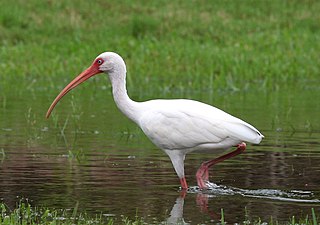
The American white ibis is a species of bird in the ibis family, Threskiornithidae. It is found from the southern half of the US East Coast, along the Gulf Coast states and south through most of the Caribbean coastal regions of Central America. This particular ibis species is a medium-sized wading bird, possessing an overall white plumage with black wing-tips, and having the typical downward-curving bill of the ibises, though of a bright red-orange color, the same hue as its long legs. Males are larger and have longer bills than females. The breeding range runs along the Gulf and Atlantic Coast, and the coasts of Mexico and Central America. Outside the breeding period, the range extends further inland in North America and also includes the Caribbean. It is also found along the northwestern South American coastline in Colombia and Venezuela. Populations in central Venezuela overlap and interbreed with the scarlet ibis. The two have been classified by some authorities as a single species.

The great black-backed gull is the largest member of the gull family. Described by the Cornell Lab of Ornithology as "the king of the Atlantic waterfront", it is a very aggressive hunter, pirate, and scavenger. It breeds on the European and North American coasts and islands of the North Atlantic and is fairly sedentary, though some move farther south or inland to large lakes and reservoirs. The adult great black-backed gull has a white head, neck and underparts, dark grey wings and back, pink legs and yellow bill.

The common raven is a large all-black passerine bird. It is the most widely distributed of all corvids, found across the Northern Hemisphere. It is a raven known by many names at the subspecies level; there are at least eight subspecies with little variation in appearance, although recent research has demonstrated significant genetic differences among populations from various regions. It is one of the two largest corvids, alongside the thick-billed raven, and is possibly the heaviest passerine bird; at maturity, the common raven averages 63 centimetres in length and 1.47 kilograms in mass. Although their typical lifespan is considerably shorter, common ravens can live more than 23 years in the wild. Young birds may travel in flocks but later mate for life, with each mated pair defending a territory.
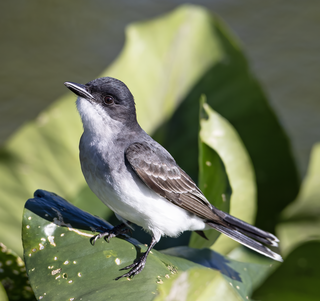
The eastern kingbird is a large tyrant flycatcher native to the Americas. The bird is predominantly dark gray with white underbelly and pointed wings. Eastern kingbirds are conspicuous and are commonly found in open areas with scattered trees and bushes, where they perch while foraging for insects. The Eastern kingbird is migratory, with its breeding range spread across North America and its wintering range in Central and South America.
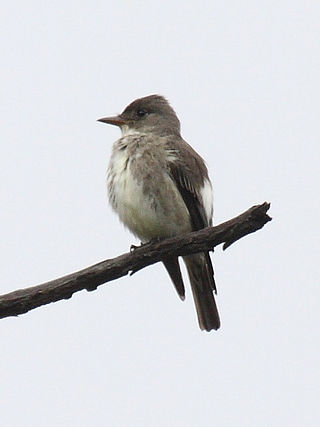
The olive-sided flycatcher is a small to medium sized passerine bird in the family Tyrannidae, the Tyrant flycatcher family. It is a migratory species that travels from South to North America to breed during the summer. It is a very agile flyer and mainly consumes flying insects on flight. Since 2016, this species has been assessed as being near-threatened globally (IUCN) and threatened in Canada (SRA) due to its declining populations.

The marsh wren is a small North American songbird of the wren family. It is sometimes called the long-billed marsh wren to distinguish it from the sedge wren, also known as the short-billed marsh wren.

The Cuban crow is a crow species native to the northern Caribbean.

The white-necked crow is the largest of the four Caribbean corvids. It is endemic to the island of Hispaniola ; it was formerly also extant on Puerto Rico and Saint Croix in the United States Virgin Islands, but has been extirpated from both islands due to considerable forest clearance and hunting for meat.

The Hispaniolan palm crow is a relatively small corvid endemic to the Caribbean island of Hispaniola where it was formerly very frequent, but is now reduced in population.

The great-tailed grackle or Mexican grackle is a medium-sized, highly social passerine bird native to North and South America. A member of the family Icteridae, it is one of 10 extant species of grackle and is closely related to the boat-tailed grackle and the extinct slender-billed grackle. In the southern and southwestern United States, the grackle is sometimes referred to simply as a "blackbird" or (erroneously) a "crow" due to its glossy black plumage; however, grackles form their own unique genus that is separate from other "blackbirds", such as the red-winged and Brewer's blackbirds, despite being in the same family (Icteridae). Superficially, Brewer's blackbird is one of the most visually similar species to grackles.

The Mariana crow is a species of the crow family from the tropical Western Pacific. It is a glossy black bird about 15 inches (38 cm) long and known only from the islands of Guam and Rota.



























